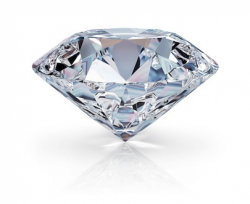Diamond

Like many gemstones, the diamond possesses a number of different symbolic meanings.
Perhaps the most famous of all gemstones, and certainly the most valuable, diamonds are loaded with symbolic meaning. Much of the gem's significance is derived from it's hardness, rarity and overall beauty, and many cultures have also assigned symbolic meaning on more specific levels. Depending on the mineral content of individual stones, diamonds can come in a whole range of different colors, but colorless stones are the most famous, as well as the most highly sought after of the family.
First, let’s talk etymology. The word diamond is derived from the Greek word “adamas”, meaning ‘invincible’. The same root also gives us words such as “adamant” and “adamantine” (as well as “adamantium” if you’re an X-Men fan). All of these words are a reference to physical makeup; diamonds are the hardest natural substance on Earth (a 10 on the Mohs Scale of Hardness), and this aspect accounts for part of their symbolic meaning: Diamonds are symbols of purity and incorruptibility, and the natural durability of the stones has come to symbolize eternity. Taking it one step further, this quality has come to symbolize eternal love, which is why diamonds are often used in engagement and wedding rings (a practice that dates back to at least the 15th century). Linguistically, this tradition is also a possible origin of the phrase “diamonds are forever”.
Such associations make the diamond seem like a largely positive symbol, but there is another side to the coin that should be addressed. While the rarity, beauty and high value of diamonds account for their positive symbolic meaning, these same factors have often spawned violence and bloodshed over control of lucrative diamond sources. For example, the famous “blood diamonds” mined in parts of Africa have been used to fund wars and illegal activities, as well as terrorism. Such diamonds can therefore been seen as symbols of cruelty and crime. With a little imagination, this kind of symbolism can be taken one step further: Historically speaking, diamonds that have passed through malevolent hands or been acquired by violent/treacherous means are sometimes said to possess “bad energy”, which was reputed to bring ill fortune to the gem's owners. The fact that trails of tragedies have (supposedly) followed in the wake of many famous diamonds as they passed from one owner to another- the Hope Diamond being an example- lends credence to such symbolism.
In terms of specific cultural examples, diamonds tend to showcase more of their positive symbolism rather than any questionable methods of acquisition. In the Old Testament, a diamond is one of twelve stones set into the breastplate of the Jewish High Priest. While these stones are commonly interpreted as representing the Twelve Tribes of Israel, they are also a possible originator of the modern concept of birthstones (one for each month of the year). In India, the diamond is one of the navaratnas, a series of nine specific gems that were used to represent the heavenly bodies as part of an ancient astrological system. In this case the diamond symbolizes the planet Venus. In Ancient Greece and during the European Middle Ages, diamonds, like other gemstones, were believed to possess protective qualities. They were used as a defense against poison, plague and even set into sword hilts to protect knights in battle.
Diamonds are also the traditional birthstone for the month of April.
© Symbols.com
